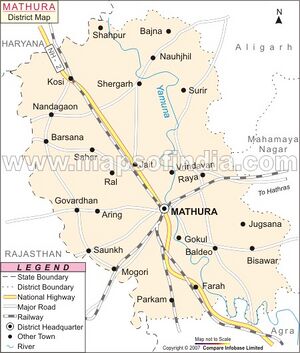Isapur Banger
| Author:Laxman Burdak, IFS (R) |
Note - Please click Issapur for similarly named villages at other places.

Isapur Banger (ईसापुर) is village in Mat tahsil in Mathura district in Uttar Pradesh. Ishapura (ईशापुर) is an ancient village in Mathura district located on Yamuna River.
Variants
Ishapura (ईशापुर) (जिला मथुरा) (AS, p.85)
History
A Kushana inscription of 24th year of rule of Vasishka was found at Ishapura.
Isapur Yupa Inscription of Vasishka
The Journal of Royal Asiatic Society, 1912 [1] mentions....[p.118]: From an historical point of view the most important discovery made during the year was no doubt that of the inscribed sacrificial post (yūpa) at 'Isapur, near Mathura (Muttra), on which a preliminary note has already appeared in the pages of this Journal (pp. 1311 ff.). It will, therefore, suffice to recall that the inscription in question, which was discovered by Pandit Radha Krishna in the bed of the Jamna, near the suburb of 'Isapur, is dated in the reign of a king called Shahi Vāsishka, and in the year 24 (expressed both in words and figures). It consequently proves the correctness of Dr. Fleet’s assumption that between Kanishka and Huvishka there reigned (at Muttra at least) a ruler of the name of Vāsishka.
This prince is also mentioned in a Sanchi inscription,1 apparently dated in the year 28. The figure expressing 20 is unfortunately damaged and therefore uncertain. It was read 70 by Cunningham and also by Dr. Buhler, who first felt inclined to read 20. The latter reading, adopted by Dr. Fleet, is most likely correct and would well agree with the testimony of the Isapur inscription.
Another interesting point to be noted in connexion with this record is that it is Brahmanical, and is the earliest
1. Cf. H, Luders’ "List of Brahmi Inscriptions”, Ep. Ind,, vol. x, appendix, p. 26, No. 161.
[p.119]: inscription in pure Sanskrit which has hitherto come to light.
The yupa of Isapur was by no means the only discovery made by Pandit Radha Krishna during the year 1910-11. Among the many sculptures acquired by him for the Mathura Museum I wish particularly to note a Bodhisattva statuette which bears the following inscription :—
L. 1. [Saṁ 10 + ] 7 va . . . ētasa purvāyā Dharmakasa sōvaṇikasa kuṭuhiniye1
L. 2. up[āsi]kā Nagapiyā (Skr.Nāgapriyā) Bodhisvatva2 pratiṭhāpeti svakāyā chitā-
L. 3. yā kaṭi ye achāryana Dharmagutakāna pratigrahe.
"In the year 1(?) 7 . . . on that date Nagapiya, a lay-member and the wife of the goldsmith Dharmaka erected a Bodhisattva [image] in her own sanctuary.3 This work4 is for the acceptance of the teachers of the Dharmagupta sect.”
Of the image unfortunately the whole upper portion above the waist is missing. The remaining part shows that the Bodhisattva was seated cross-legged, his left hand resting on the knee. We may assume that the right was raised to the shoulder in the attitude of protection (Sanskrit abhayamudrā). The style of the image is similar to that of the Any or and Khaṭrā statuettes in the Mathura Museum. On the base are figures of human worshippers, two men, two women, and two children ; all, except the children, carrying lotus-flowers as offerings.
On either end is a lion sejant in the typical conventional style of the Kushan period.
1. Read kutumbini
2. The anusvāra has been omitted over the final aksharas of Bodhisvattva, svakāyā, chitāyā, achāryana (read āchāryānām), and Dharmagutakān (read gutakānām). The curious akshara sva in Bodhisvatva, evidently a clerical error for sa, has been found elsewhere in Mathura inscriptions.
3. The word chitā (or chetā ?) is apparently synonymous here with Sanskrit chaitya.
4. The reading kuṭi ye is doubtful. I suppose that it corresponds to Sanskrit kṛtir yam, and have translated accordingly.
History
Monuments
- Siva, head found from Isapur (Mathura), Repository: Present Location: Archaeological Museum, Mathura, Museum No: No.15.980, Date: 400-499 CE[2]
ईशापुर
विजयेन्द्र कुमार माथुर[3] ने लेख किया है ...ईशापुर (AS, p.85) मथुरा (उत्तर प्रदेश) में स्थित एक ग्राम है। यह ग्राम यमुना नदी के पार और विश्राम घाट के ठीक सामने स्थित है। 1910 ई. में यहाँ से एक ही पत्थर का बना एक सुन्दर 24 फुट ऊँचा यूपस्तंभ मिला था। स्तंभ के निचले चौकोर भाग पर कुषाण काल (द्वितीय शती ई.) की ब्राह्मी लिपि में निम्न लेख खुदा है- 'सिद्धम्-महाराजस्य राजातिराजस्य देवेपुत्रस्यषाहेर्व्वासिष्कस्य राज्य संवत्सरे (च)-तुर्विशे 24 ग्रिष्मा-(म) मासे चतुर्त्थे 4 दिवसे त्रिंशे 30 अस्यांपुर्व्वायां रुद्रिलपुत्रेण द्रोणलेन ब्राह्मणेन भारद्वाज सगोत्रेण माणच्छंदोगेन इष्ट्वा सत्रेन द्वादशरात्रेण यूप: प्रतिष्ठापित: प्रीयतामग्न्य:।'
अर्थात् 'कल्याण हो, महाराजाधिराज देवपुत्र पाहिवासिष्क के चौबीसवें राज्यवर्ष में, ग्रीष्म ऋतु के चौथे मास में, 30वें दिन, रुद्रिल के पुत्र भारद्वाज गोत्रीय ब्राह्मण द्रोणल ने जो माणछन्द का अनुयायी है, द्वादश-रात्रियज्ञ को करके इस स्थान पर यह यूप प्रतिष्ठापित किया। अग्नि देवता प्रसन्न हों'।
जाट इतिहास
ठाकुर देशराज[4] लिखते हैं कि कनिष्क के मरने के बाद शासन-सूत्र वासिष्क के हाथ आया। यह पिता की अनुपस्थिति में भी राज्य कार्य संभालता रहता था। मथुरा के पास ईसापुर में इसका एक लेख मिला था जो कि आजकल मथुरा के अजायबघर में है। यह पत्थर के एक यज्ञ-स्तम्भ पर है। उस पर विशुद्ध संस्कृत में लेख खुदा हुआ है। जिस पर इसे “महाराज राजतिराज देव पुत्रशाहि वासिष्क” लिखा हुआ है। कुछ लोगों का कहना है कि इसका राज्यकाल कनिष्क के राज्यकाल के अर्न्तगत था।
Monuments
Notable persons
References
Back to Jat Villages

